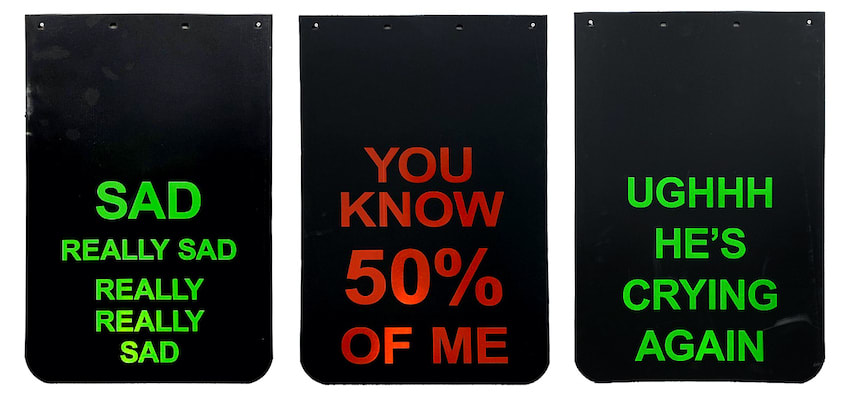
In Gallery 2 Western Exhibitions will present an unconventional multiple by one of our favorite artists Cary Leibowitz, rubber semi-truck mud flaps that are printed with axioms like “Vote for a Teenager,” “World’s Best Queen Esther Rodeo: No More Round Ups,” “Faggy Faggy Boom Boom,” and “Ughhh He’s Crying Again.” This show is presented in collaboration with New Discretions. At the time of this release (July 2020), the show will not have an opening reception and will be open by appointment, Tuesday through Saturday, 11am to 5pm. Please email or call (312) 480-8390 or visit Tock to schedule a visit.
For decades, Leibowitz has been the New York art world’s master painter of abjection and neurosis, self-loathing, self-doubt, and self-interrogation—“like a human dynamo of insecurity,” Rhonda Lieberman wrote in Artforum in 1992. In those years, he was still known as Candyass, a prankster-critic of neo-expressionist grandiosity—and one whose self-mocking good humor belied a universe of anxiety below the surface, particularly as the AIDS crisis devastated New York. He hosted a talk show (Talk Show), appointed himself the director of Fake Chanel (a menorah was a collection centerpiece), became a sort of poster-boy for the Pathetic Aesthetic, and turned sleek, self-important galleries into Candyass Carnivals full of pennants blaring irony, Americana paintings that managed to have it (i.e. the whole American vernacular tradition) both ways, valentines to underappreciated movie stars, and multiples that mocked art-as-commerce even as they were offered, themselves, for sale. His uproarious text paintings of self-lacerating one-liners, typically composed against pastel-colored wood “canvases,” were a self-conscious counterpoint to neo-expressionist grandiosity and the new pop spectacle of the art world of the time (mixing elements of therapy, interrogation, social and institutional critique, and stand-up comedy routine). But his work was also and always deeply personal and idiosyncratic, driven by anxieties, neuroses, and premonitions of difference—and by the nagging of crippling conscience that lies always beneath, or behind, or just around the corner, with a mocking and knowing wink.
Cary Leibowitz’s work has shown in museums and institutions across the globe including The Institute of Contemporary Art, Boston, Massachusetts; The Walker Arts Center, Minneapolis, Minnesota; the Frankfurter Kunstverein, Frankfurt, Germany; The Aldrich Museum of Contemporary Art, Ridgefield, Connecticut; the Guggenheim Museum, New York, New York; The Whitney Museum of American Art, New York, New York; The Jewish Museum, New York, New York; Museum of Modern Art, PS1, New York, New York; The Indianapolis Museum of Art, Indianapolis, Indiana; The Wexner Center for the Arts, Columbus, Ohio; The Andy Warhol Museum, Pittsburgh, Pennsylvania; Badischer Kunstverein, Karlsruhe, Germany; White Columns, New York, New York; Philadelphia Museum of Jewish Art, Philadelphia, Pennsylvania; Art Metropole, Toronto, Canada; Kunstverein für die Rheinlande und Westfalen, Düsseldorf; Bonner Kunstverein, Bonn, Germany; Cabinet Gallery, London, United Kingdom; Galleri Nicolai Wallner, Copenhagen, Denmark; Art Institute of Chicago, Chicago, Illinois; Galerie Claudio Botello, Turin, Italy; List Visual Arts Center, Massachusetts Institute of Technology, Cambridge.
Leibowitz’s first comprehensive career survey and solo museum exhibition, Museum Show, originated at The Contemporary Jewish Museum, San Francisco in 2017 and traveled to The Institute of Contemporary Art, Philadelphia, and The Contemporary Art Museum, Houston in 2018. Leibowitz’s work has been included in the landmark exhibitions Too Jewish? Challenging Traditional Identities at The Jewish Museum in New York, New York; In a Different Light at the University Art Museum, University of California at Berkeley; and Bad Girls, New Museum, New York, New York. His work has been reviewed in The New Yorker, Artforum, The New York Times, Frieze Magazine, and Art in America, among others.



